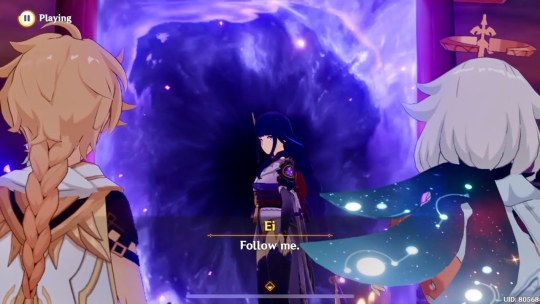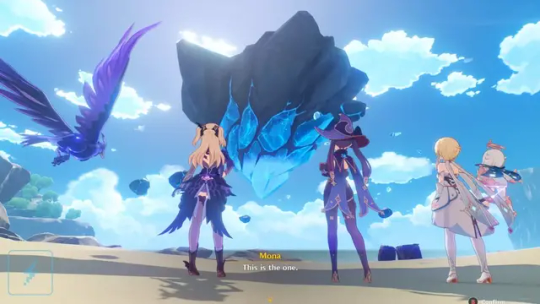Text
🤔



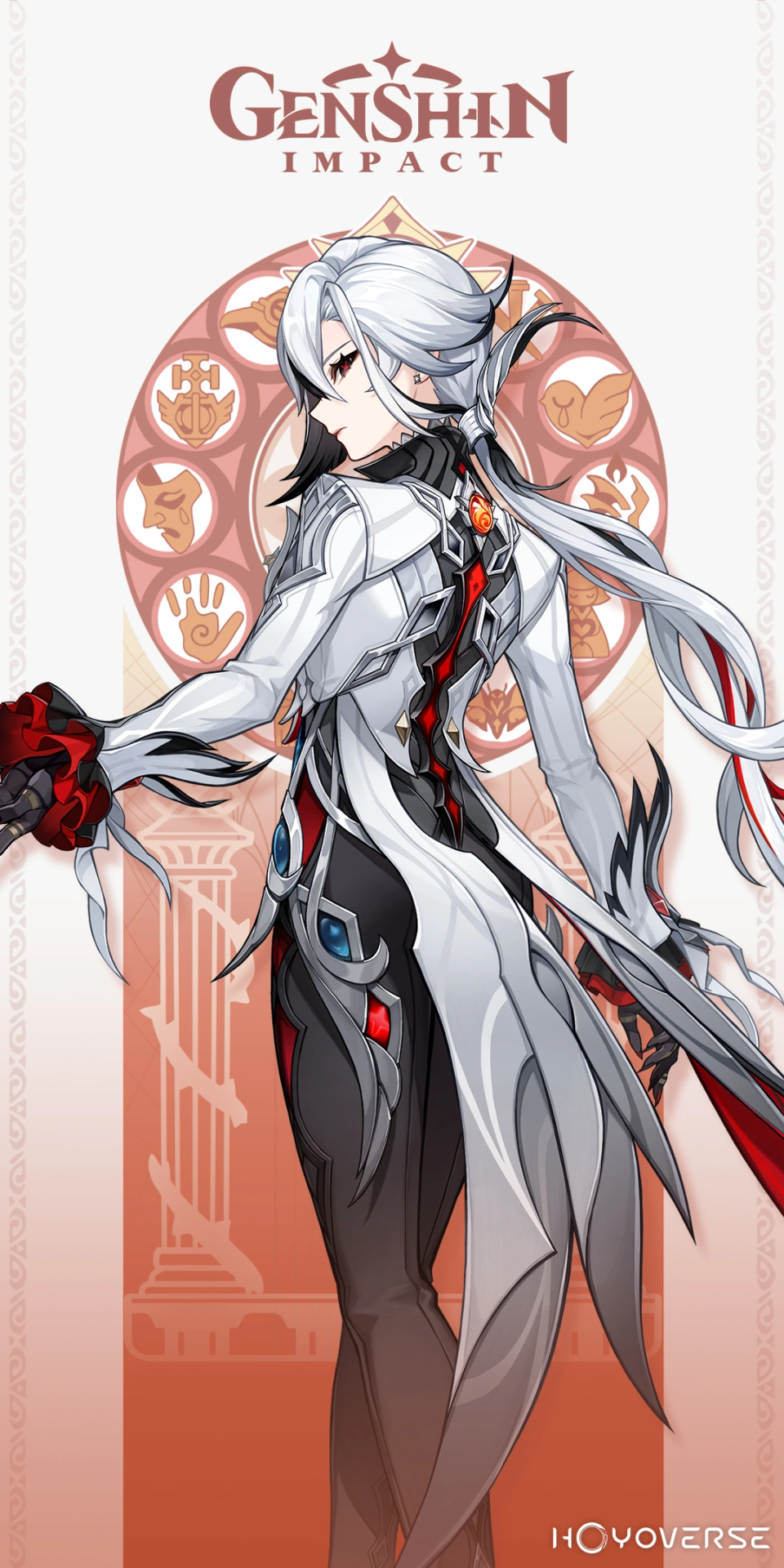
(shot in the dark, not theory or anything)
Fontaine is heavily influenced by the 1927 silent film Metropolis, the mother of dystopian sci-fi.
The character Maria is a Virgin Mary expy who represents Christian beliefs, paralleled in Fontaine by Focalors, while her robot version that represents blasphemous beliefs (or a threat to Christianity) is paralleled by Furina. In the context of Fontaine chapter, this is to signify that Furina has brought about the end of the archon rule.
The Grim Reaper has a very short appearance, first when Freder (the Christ figure and protagonist) vows to not fall into temptation in front of the statues; and then acting as a commander of the seven deadly sins that awaken when robot Maria seduces the upper class city men in the surface into gambling, violence and lust.

The role of the devil in the movie is played by a different character (the mad scientist who created robot Maria) and the Grim Reaper is more a symbolic representation of robot Maria’s influence on the city. It works in unison with robot Maria, the shots are paired with her “erotic” dance in full Whore of Babylon gear.
The statues of the deadly sins also become the support of the platform in which robot Maria performs, and the text reads “For her — all seven deadly sins!” during the scene.
Like I said before, the role that Furina has as the apocalyptic “false” idol in the Fontaine chapter is positive, as it restores the Sovereign’s power to Neuvillette, therefore...? so should the actions of the Grim Reaper?

15 notes
·
View notes
Text
How long has it been since world quest lore featured in an archon quest or a character story quest? I feel like putting together lore used to pay off a lot more before compared to now.
Scaramouche’s story was cooked slowly from his first appearance in 1.1 Unreconciled Stars, that’s how early fans started speculating about his connection to Raiden based on his visual similarities to Honkai’s Mei and afterwards all the lore hidden in item descriptions. It’s the main reason why he was so popular in the first place and why getting invested in his lore felt like it paid off, despite the disagreement with some writing choices.
Another huge one was Signora, I still remember the post that started speculations about her being the Crimson Witch of Flames.
But I try to think something more recent and there isn’t rly anything that stands out. Fontaine’s aq didn’t feature anything relevant from Remuria’s lore, the Caribert quest had no lore foreshadowing, same for Sumeru, same for The Chasm and Dainsleif quests. They drop lore bombs and occasionally answer one or two questions, but at the same time raise a dozen more.
I’ve made some correct guesses in every important update, but only based on thematic elements and every time I watch other fans put a lot of effort into trying to solve the puzzle with the information provided by the game only to end up disappointed. A lot of events and quests don’t make sense to people because of that. And then I’ve also been mislead by themes I thought the narrative had promised me only to end up empty handed.
I can’t know how other fans feel, but it’s the reason why I’ve become burnout, stopped playing the side quests since there’s no payoff. There’s always theories trying to solve the various mysteries presented in the game, so I can just read through those instead. Chances are it won’t be used in the story, so I know I won’t miss out on the feeling of solving something by myself. Most of Fontaine can be explained just with the movie Metropolis and the Bible, there’s no reason for me to look for more info in the game unless I want to learn the whole history, knowing it doesn’t explain much by itself.
I had my hopes on Arleccchino, but again there was no buildup and no foreshadowing besides the recently released Perinheri book. Knowing her lore beforehand, scattered in world quests in Inazuma and Sumeru, also didn’t pay off because the game withheld information about it that changed the interpretation of these quests.
The company seems to rely a lot on the hype of these red herrings, but then it exhausts their audience and soon it might not work anymore because people feel like characters and major elements get basically retconned, even though they aren’t. All fiction thrives on plot twists, but when ur medium creates and supports certain expectations over months only to deliver something unexpected, it rather ruins the fun of those invested in it. And I’m saying this as someone who’s already used to it, I don’t trust the game to deliver what they promise anymore, so I had no expectations about Arlecchino for example. But it’s clear a lot of other fans did, based on what they were promised and reassured for months before new information was introduced that contradicted those expectations.
1 note
·
View note
Text
The parallels between Wriothesley and Arlecchino seem interesting.
Wriothesley’s constellation is Cerberus, so that frames underwater Meropide as a parallel to hell where he is the guardian. His chibi in an official illustration also was made to look like a demon.
Following the religious themes, Arlecchino’s orphanage could be a parallel to the limbo of unbaptized kids. Thematically, she’s the grim reaper, which is not the same as the devil (Genshin isn’t that strict in that regard, so it could work simultaneously either way).
So we have these two character who were handed a sentence for a crime, Wriothesley for killing the foster parents that trafficked children and Arlecchino for killing the orphanage’s director who subjected the children to a battle royale of sorts, and participate in the system but at the same time make choices that better the conditions of the souls they’re in charge of.
#Short post#ramblings#come on Genshin I believe in you it’s the goddamn nation of justice just ask the goddamn question#ask what does justice really mean#ask if justice is always fair
0 notes
Text
My biggest frustration with how Ei has been interpreted for years now is this assumption that her grief has to do with denial and not moving on from Makoto’s death, which she was struggling with still but not in the way everyone believes.
She’s not holding onto the past or denying the present, she’s scared of losing what remains. Her grief comes in the shape of holding onto everything dear to her for life, even if she must sacrifice her self for it.
And nobody knows of that eternal sacrifice, she herself doesn’t even consider it a sacrifice. To her, it’s her duty and reason for existing. She’s a tool for Inazuma’s survival.
It doesn’t occur to her she doesn’t deserve this until Yae says “eternity is far too cruel a fate for you”
#Genshin lore#Short post#ramblings#SHE HURTS ME SO BAD#I love her a lot#Ei could get similar sympathy as Furina gets if people just See
4 notes
·
View notes
Text

Those who do not work shall not eat
Sign inside the Fortress of Meropide, probably a reference to the Bible where the quote originated, but also a funny jab at Lenin’s use of it in one of his works.
Although Meropide’s system works the way capitalism is intended to work in theory, with its core values and promises fulfilled, part of its superficial depiction also reminds of communist elements (the vouchers, the lack of social class, etc). But then Meropide is also a prison that provides labor for the surface city, so what does that really say about this idealistic application of capitalism.
Either way, Lenin realistically understood that communism couldn’t be achieved overnight, and that the transition through socialism would still function under bourgeois law. So this principle of equal remuneration would shape society into embracing work, otherwise the upper clasess who were used to work little (or just owning labor) for higher profit would remain the same. One should lead with example, anyway.
There’s disagreement on the interpretation of this quote, of whether Lenin meant equal exchange of labor for product with needs already satisfied, or if he just wanted disabled people to die.
Wriothesley seems to agree with the first one, since he still provides the basics regardless of if convicts work or not, but then again this is an idealistic depiction of capitalist theory and myth.
3 notes
·
View notes
Text
the deadly sins? 🤨
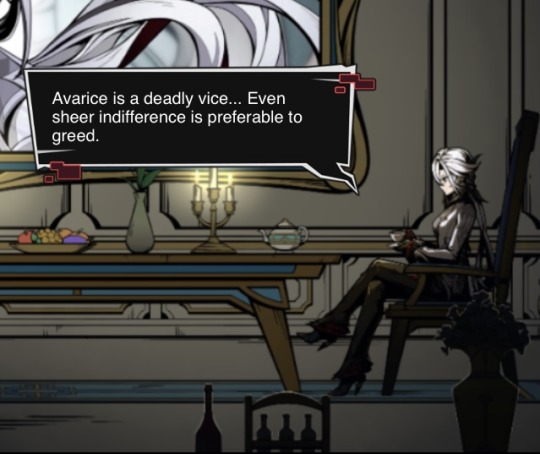


(shot in the dark, not theory or anything)
Fontaine is heavily influenced by the 1927 silent film Metropolis, the mother of dystopian sci-fi.
The character Maria is a Virgin Mary expy who represents Christian beliefs, paralleled in Fontaine by Focalors, while her robot version that represents blasphemous beliefs (or a threat to Christianity) is paralleled by Furina. In the context of Fontaine chapter, this is to signify that Furina has brought about the end of the archon rule.
The Grim Reaper has a very short appearance, first when Freder (the Christ figure and protagonist) vows to not fall into temptation in front of the statues; and then acting as a commander of the seven deadly sins that awaken when robot Maria seduces the upper class city men in the surface into gambling, violence and lust.

The role of the devil in the movie is played by a different character (the mad scientist who created robot Maria) and the Grim Reaper is more a symbolic representation of robot Maria’s influence on the city. It works in unison with robot Maria, the shots are paired with her “erotic” dance in full Whore of Babylon gear.
The statues of the deadly sins also become the support of the platform in which robot Maria performs, and the text reads “For her — all seven deadly sins!” during the scene.
Like I said before, the role that Furina has as the apocalyptic “false” idol in the Fontaine chapter is positive, as it restores the Sovereign’s power to Neuvillette, therefore...? so should the actions of the Grim Reaper?

15 notes
·
View notes
Text
i wonder if arlecchino is trying to fullfil a ruse similar to how focalor tried to trick the heavenly principles.... by that i mean: keeping the appearance that "fate" is coming to pass (the choosing of a 'King' for the house of hearth) while secretly keeping a second plot happening in the background that will make it so that will not happen....
i mean, it's clear she's not making her children fight eachother to the death, so that's good -and already a step-up from the previous knave. but why IS she fighting the siblings on the trailer.........
#Someone in the subreddit compared the bit about the child in the chimney in perinheri to Schrödinger’s cat#Maybe she needs the kids to ‘kill’ her as the previous king in a way that defies the logics of reality so that she’s both dead and alive?#It could fool fate
21 notes
·
View notes
Text
Does Genshin the game really care all that much about the morality of their characters?
Like a story is allowed to pick which elements it draws attention to in order to make the points it needs to make. So Scaramouche is granted an arc revolving around regretting his actions and admitting he’s done wrong, because his character is based on Buddhism and such story explores the concept of karma; while things like traveler committing genocide against the Tanit tribe and wiping out an entire clan in Inazuma is never questioned as the correct course of action, because the story doesn’t see any value in its moral dilemma —universally, this is not an acceptable thing to do, but the story had no points to make about it.
Fontaine so far is the most complicated nation in this aspect, where the story doesn’t bother all that much with the heavily charged morality (or lack there of) of life in the city, even though there’s so much that could be explored. For instance, something I keep complaining about because of the inspirations on Metropolis: the fact there are citizens living in the sewers and how ex convicts stay in the prison after completing their sentences due to the discrimination they face outside. Fontaine is highly unequal, yet the writing is not concerned with giving these aspects any more depth than an acknowledgement.
Perhaps as an audience we’re not meant to dwell on it, the story had other goals that it has achieved. But it also conveniently avoids placing responsibility or blame on the main and playable characters, specifically characters like Neuvillette and Furina who had been ruling the nation together. If we paid too much attention to these issues presented in the city, we’d start wondering why Neuvillette’s infinite compassion doesn’t extend to the children who play in the sewers and the prison. It’s almost like the writing intends us to observe these narratives in two different planes, divorced from the main storyline played by the main characters.
And that’s fine, I don’t personally mind suspending belief over something like this.
So I wonder if Arlecchino’s character will go a different route about the fact the orphanage is a child soldier factory. It seems she inherited it as part of the punishment for killing Cucrabena, and she takes care of the children in making them stronger to survive the harsh life they’ve been handed. It would be hypocritical, like the things I named earlier, to address Arlecchino’s moral dilemma without burning (heh) other main characters.
Because, first, why are there so many orphans in the nation where children are born by wishing at the fountain? In theory, there should not be this many unwanted children. Second, if there are this many orphaned children that the Fatui are taking advantage to fill their ranks with them, why hasn’t the government done something about it? Do they think it’s an appropriate measure, since the kids get a chance to survive and get extra criminal skills? Focalors’ plan relied on the machine accumulating power from the trials, so were the orphaned child soldiers the price to pay? Either by feeding the machine with criminals or by imprisoning their parents so they’d end up orphaned. There’s a lot of crime that goes unpunished in the city, for example, by individuals engaged in child trafficking, to the point characters like Wriothesley in his youth or Arlecchino take justice in their own hands. Nobody batted an eye to Cucrabena’s battle royale orphanage either. And the institute pays little attention to the freak accidents that kill workers.
So, at this point, is it really worth it for the writing to address the moral dilemma of Arlecchino’s orphanage without altering the perception of other characters like Neuvillette? It certainly could, and then just never mention how the entire system allows for it to happen, but me as the audience can’t say that I will care all that much. The writing has gone out of its way to downplay the buildup to her character, even adding new dialogues that exonerate her from what happened in the fortune slip quest in Inazuma, since that was the fault of the previous Knave. And the orphanage itself is a punishment imposed on her by the Fatui.
#Long post#Whining#By which I mean:#1. The region makes no sense#2. It doesn’t matter the logic is altered to tell a story and I’m gonna be paying attention to that story#except I’m gonna be annoying about the two specific things#3. If they’re framing arlecchino in a way where her violence is justified and the child soldiers are part of the local lack of logic#then just eat the food damn
3 notes
·
View notes
Text
about the three betrayals
None of the betrayals independently made Scara who he became, it was an evolution of things. None of these independently pushed Scara into making bad choices, and it feels a bit that fans either push the blame on Ei’s negligence or Dottore’s manipulation, as if either of these two had set the path for Scara on their own, while at the same time interpreting the third betrayal as a misunderstanding or an exaggeration (because what fault would a child have in his own death?) but it misses the point of the betrayals as a whole.
The ideas of inferiority influenced by being abandoned might have formed early, but they didn’t meaningfully influence Scara’s existence while he lived in Tatarasuna. Ei left him the golden feather so that if he wanted to, he could contact her, his creator, but he never did until Tatarasuna was in danger. He had no need to investigate the reason of his existence, so he never sought an audience with the shogun until it was necessary and only as a last resort (other villagers had tried to leave the island to ask for help already).
Niwa’s false betrayal didn’t make him snap either, he left the village to never return, but he immediately formed a new bond with another human. Being harmed by another person, especially one that Scara was made to believe had done intentionally, did not make him lose hope in humanity. Seeing his compassion and kindness for the child, it also didn’t turn him cynical or resentful.
Both of these things affected him very deeply, he longed for a heart to truly be a human and he only formed this new bond with a human he considered equal. But they did not shape who he became alone. It was the third betrayal, hence why the three of them are important to understand him.
It’s not that the child dying was a betrayal of its own, Scara didn’t even resent him, he even goes back to visit his grave. It’s the fact that even when humans don’t purposefully cause him pain, they still will hurt him. Any and all potential connection to the world he forges will eventually be severed by death. And this natural course of life is not available for him, he doesn’t belong to this world, doesn’t have a place in it.
If you remove the first or the second betrayal, which are largely seen as something that was done to him with intent, the third betrayal still stands. All three of them shaped him, not just the ones where he was hurt intentionally. And that’s the point, that he can’t escape the suffering of his existence.
The first betrayal was never what he assumed it to be, Ei didn’t abandon him for “being flawed”, she did it to not impose a will on him. She had her reasons for this, since she herself viewed herself as a tool with a purpose and understood right away the conflict of Scara’s nature (“he’s fragile both as a human or as a tool”). It was a decision influenced by her own world view and reasoning, and it had tangible consequences.
The second betrayal was a lie, Niwa didn’t betray him at all. Dottore deceived him, but Dottore doesn’t consider himself a human, he sees all living beings as test subjects, none of what he did was strictly personal to Scara. No human chose to harm him, that’s the explanation behind this betrayal, and it had tangible consequences.
The third betrayal revealed the nature of his own existence to him, there was no intentions behind it and it still had tangible consequences.
This is central belief in Buddhism, which Scara’s character is built around. Suffering exists in the world as a fact, it cannot be escaped, and this suffering exists in a chain of cause and consequence: Karma. All actions are preceded and followed in this chain by other actions, and trying to look for the original cause of pain is meaningless. So pain must be dealt with in other ways. Basically the “nothing matters” meme with a thumbs up.
Karma is also the impulse behind the action, not the action itself. So all actions are deliberately made by individuals who decided to act on that impulse. The mistakes and bad choices Scara made after these betrayals are his own to reflect on, they can’t be blamed in whoever participated in the making of that karma, but it is understood that they exist in a chain of events that triggered each other.
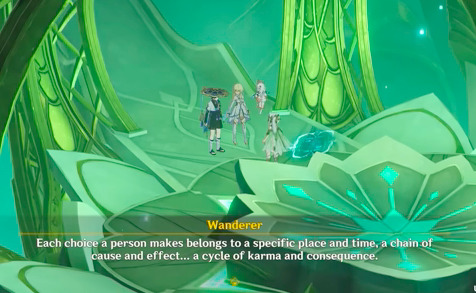
14 notes
·
View notes
Text
Metropolis influence on Fontaine
Metropolis is a 1927 German silent film about a city divided into upper class surface and working class underground that focuses on the impact of industrialization, at the same time serving as a dystopian allegory for the Bible. If you know any other fictional work with a similar setting, chances are it was inspired by Metropolis either directly or indirectly.
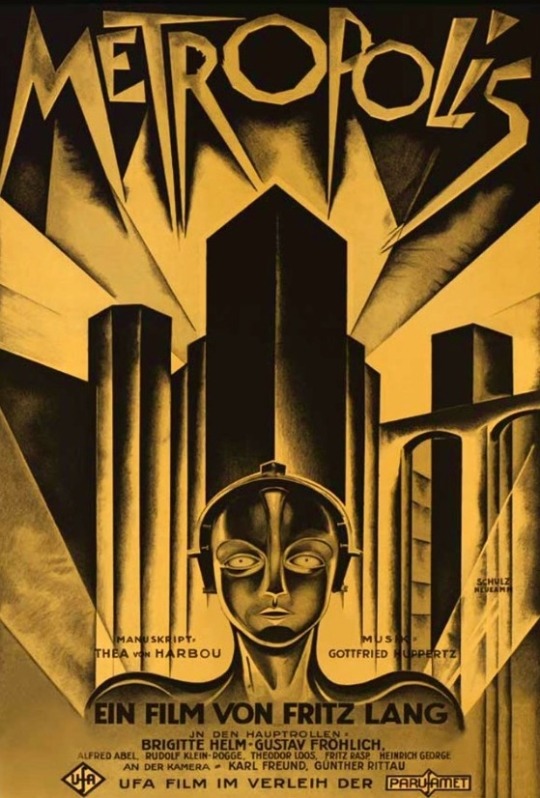
The original footage suffered cuts during the Nazi regime, and although it was restored in the following decades, there’s still missing scenes that are filled with black screens and text. The most complete version is available on YouTube
Visuals
Director Fritz Lang said he was inspired to create the architecture of the city on his trip to New York. Both Metropolis and Fontaine feature ridiculously tall buildings with suspended highways (in Fontaine these are for the Aquabus) that intend to express a futuristic look yet follow the trends of its time.
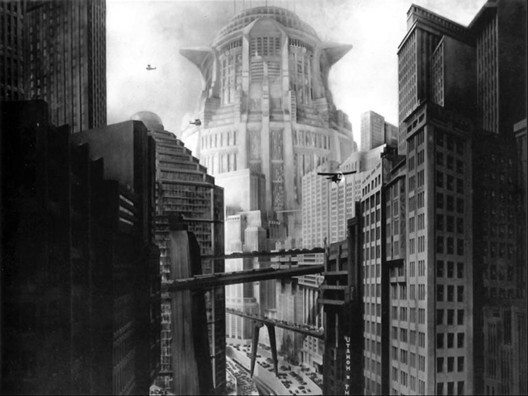
It is notoriously influenced by the Art Deco movement, which Fontaine also relies on for its overall design (geometry, symmetry, bright colors)
From Wikipedia:
During its heyday, Art Deco represented luxury, glamour, exuberance, and faith in social and technological progress. The movement featured rare and expensive materials, such as ebony and ivory, and exquisite craftsmanship.
The underground workplace of the city also looks like a giant factory, similar to the Fortress of Meropide.

Ideology
Due to the depiction of an exploited class that the elites profit off and the harsh conditions of industrial labor, it is largely considered to be an anti-capitalist movie.
A random review in The New York Times from 1927 acknowledges the antagonist as a capitalist:

We see a similar dynamic between Fontaine City and the Fortress of Meropide, whose convicts produce the mecha that the nation relies on. The convicts stay in the prison after finishing their sentences because they suffer discrimination in the surface, and at Fontaine Research Institute seems to prioritize scientific advancement instead of the lives and health of their workers.
However, to put it simply, a Marxist story it is not. Neither of them.
The Fontaine chapter briefly addresses the inequality between the surface and underground, but doesn’t engage with it any further. And although the plot of the AQ quickly deviates from the themes of class struggle to focus on the bigger picture, it doesn’t betray the narrative of the source material either.
The politics in Metropolis are centrist at best, the workers are lured into committing acts of violence without a purpose other than chaos by an idol of false belief (depicted in the movie as a robot, but it’s meant to be a parallel of pagan gods in the Bible). This same false idol temps the upper class men in the surface into self indulgent pleasure and violence, so the movie equates the motivations of the working class to revolt against a unjust system to that of the ruling class who maintain and abuse that system. Both are naive, unthinking, acting on carnal desire and senseless chaos.
The thesis that the movie presents is one in favor of keeping the hierarchical status quo between the dominating class and the class that is dominated. As if inherently assigning an intellectual role to the upper classes and a manual labor role to the lower, the surface is called the “head” and the underground is called the “hands”, which should be mediated with a “heart”.
Fritz Lang admitted this fault decades later:
“I was not so politically minded in those days as I am now. You cannot make a social-conscious picture in which you say that the intermediary between the hand and the brain is the heart. I mean, that's a fairy tale—definitely. But I was very interested in machines. Anyway, I didn't like the picture—thought it was silly and stupid”
As a side note —and why it matters that the interpretation of the film doesn’t confuse anti-capitalist themes with Marxist ideology— Goebbels, the chief propagandist of the Nazi Party, personally approached the director to ask him to join because Hitler watched and liked Metropolis. Lang refused and escaped Germany due to fear of being targeted for his Jewish ancestry, but the book that the movie is based on was written by his wife, who would join the Nazi Party herself later.
The story aims to maintain the status quo of class while promoting Christianity, a double indoctrination of sorts. It wasn’t odd that Goebbels would value it as a tool for propaganda.
Christianity & Plot
Both stories are based on the Bible, specifically the apocalyptic texts in the Old Testament.
The protagonist plays the role of the messiah (ya boi Jesús) that must mediate between “head” and “hands”, an allegory for the messiah’s role in the Bible that reconciles God with humanity (after the whole dying for their sins business). He switches place with a worker and experiences the underground by himself, the same way god sends his son slash third part of himself to live as a human.
Neuvillette plays this role in the AQ, acting as the “mediator” between the power of the Sovereigns and humans. Beyond that there’s not much similarity with the movie (unless you’re a neuvifuri shipper), but they do make the same points in regards to Christian myth. Neuvillette also has his own arc of living among humans and learning to “be” one.
On the other hand, the character Maria represents Christian values and belief, and acts as a sort of prophetess for the underground people. She preaches about a mediator who will come to save them, and it is her who awakens the protagonist’s curiosity to venture down the underground city. So it is her who basically brings the Jesus figure into the world like a Virgin Mary expy. The two fall in love later.
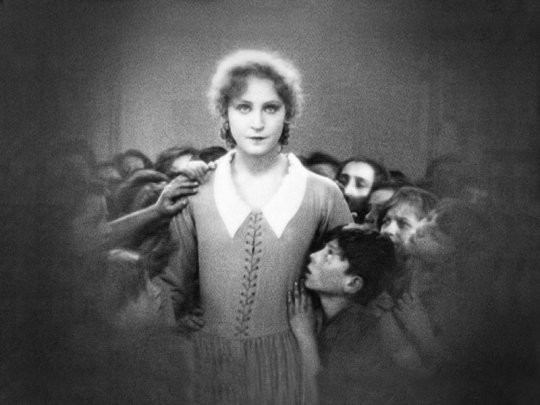
This would be our Focalors, the real god of Fontaine who plans for Neuvillette to help the nation from the start.
The antagonists of the movie are the major of the city (who fulfills the role of the kings in the Bible) and a mad scientist (who fulfills the role of the devil), both conspire to create a robot version of Maria in order to suppress the workers uprising. Robot Maria represents an idol of false belief, in the Bible these are the pagan gods that people follow into their own ruin.
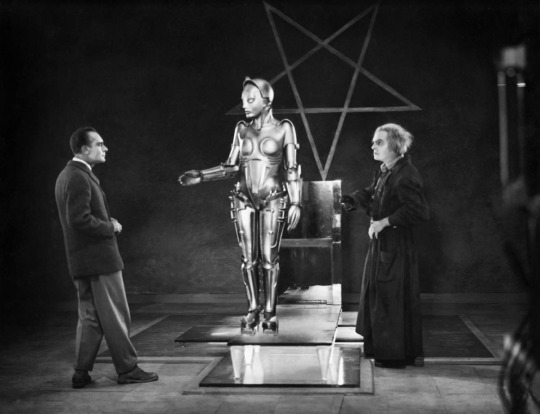
The mad scientist betrays the major and also sends robot Maria to the surface, where she spreads chaos in the form of the Whore of Babylon, an apocalyptic omen of the Bible.

This is our Furina, except Genshin subverts the character by making her the human part of Focalors instead. Furina’s official title (“Regina of all waters, kindreds, peoples and laws”) is a reference to the Whore of Babylon, and in the context of the AQ it’s meant to signify that Furina has caused the end of the archon rule in the nation.
In the movie robot Maria is burned at the stake by the workers in the middle of their violent frenzy, and they discover she is a machine while the real Maria is alive —Christianity wins. In Fontaine, Christianity kills herself (😭) and the apocalyptic idol of false belief stays alive. Perhaps the true values the people should follow are humane ones and not religious, who knows.
A flood also takes place during the climax of the movie, caused by the workers’ revolt, which the protagonist and the real Maria contain to save the children of the workers.
Although not Christianity per se (the original book had a lot more of occultism than the movie) the role of the Grim Reaper, a rather symbolic character, seems to be paralleled by Arlecchino. It’s a character that represents the influence of robot Maria on the city as she spreads chaos, they work in unison while being two characters independent from each other.

20 notes
·
View notes
Text
looking through other references in her kit, it does seem to lean into the figure of the grim reaper. not as an antagonistic force (like the devil) but a part of the cycle of life, like a necessary element for rebirth
there’s a reference to a poem called the reaper and the flowers, which depicts the grim reaper as gentle and mournful when collecting souls in the form of flowers
As she sees it, not every grain of wheat that falls upon the earth will grow into an ear, while those who obstruct her, once burned to ashes, can certainly be used to nourish flowers.
Arlecchino, rather than feeling sorry, justifies this cycle where something is used to nourish another
there’s also a reference to the story of the masque of the red death by Edgar Allan Poe, where a man tries to escape death in vain. feels similar to the concept of blood debt in arlecchino’s kit and her actions against her enemies (those who enrage her/get in her way) are framed as retribution of sorts (also kinda funny that there’s a fatui mob who uses pyro attacks and is a debt collector)
because of this context, it makes her feel like an executioner haha in terms of historical parallels with the French revolution
the things that I can’t really analyze are the elements of purifying fire and the moon, none are characteristic of metropolis, historical context or christianity
the concept of purifying fire in the Bible is used more metaphorically, the fire is whatever battle gods decides to give u. the person faces the problem, changes, and comes out a better person thus is purified through fire
if it’s not that, then the only thing I can think about is gehenna. the fire of hell in the collective imagery of the church is not purifying and it’s not really canon, gehenna is the actual place in the Bible that I think worked more as some sort of limbo. it was originally a garbage dump where outcasts would end up, something like that
some biblical angels like the ophanim were described as being on fire, but idk
as for the moon, I really don’t know. the stories about crucabena and the kid aren’t related to the moon either. it’s a red moon, so an eclipse but other than being related to genshin’s own khaenri’ah canon I can’t guess what it’s supposed to mean


(shot in the dark, not theory or anything)
Fontaine is heavily influenced by the 1927 silent film Metropolis, the mother of dystopian sci-fi.
The character Maria is a Virgin Mary expy who represents Christian beliefs, paralleled in Fontaine by Focalors, while her robot version that represents blasphemous beliefs (or a threat to Christianity) is paralleled by Furina. In the context of Fontaine chapter, this is to signify that Furina has brought about the end of the archon rule.
The Grim Reaper has a very short appearance, first when Freder (the Christ figure and protagonist) vows to not fall into temptation in front of the statues; and then acting as a commander of the seven deadly sins that awaken when robot Maria seduces the upper class city men in the surface into gambling, violence and lust.

The role of the devil in the movie is played by a different character (the mad scientist who created robot Maria) and the Grim Reaper is more a symbolic representation of robot Maria’s influence on the city. It works in unison with robot Maria, the shots are paired with her “erotic” dance in full Whore of Babylon gear.
The statues of the deadly sins also become the support of the platform in which robot Maria performs, and the text reads “For her — all seven deadly sins!” during the scene.
Like I said before, the role that Furina has as the apocalyptic “false” idol in the Fontaine chapter is positive, as it restores the Sovereign’s power to Neuvillette, therefore...? so should the actions of the Grim Reaper?

15 notes
·
View notes
Text


(shot in the dark, not theory or anything)
Fontaine is heavily influenced by the 1927 silent film Metropolis, the mother of dystopian sci-fi.
The character Maria is a Virgin Mary expy who represents Christian beliefs, paralleled in Fontaine by Focalors, while her robot version that represents blasphemous beliefs (or a threat to Christianity) is paralleled by Furina. In the context of Fontaine chapter, this is to signify that Furina has brought about the end of the archon rule.
The Grim Reaper has a very short appearance, first when Freder (the Christ figure and protagonist) vows to not fall into temptation in front of the statues; and then acting as a commander of the seven deadly sins that awaken when robot Maria seduces the upper class city men in the surface into gambling, violence and lust.

The role of the devil in the movie is played by a different character (the mad scientist who created robot Maria) and the Grim Reaper is more a symbolic representation of robot Maria’s influence on the city. It works in unison with robot Maria, the shots are paired with her “erotic” dance in full Whore of Babylon gear.
The statues of the deadly sins also become the support of the platform in which robot Maria performs, and the text reads “For her — all seven deadly sins!” during the scene.
Like I said before, the role that Furina has as the apocalyptic “false” idol in the Fontaine chapter is positive, as it restores the Sovereign’s power to Neuvillette, therefore...? so should the actions of the Grim Reaper?

#or it’s only an aesthetic thing is all#arlecchino#Genshin lore#or maybe they’re just homosexuals#by which I mean whatever the hell she ends up doing beyond her duties to the tsaritsa may also be against celestia but who tf knows
15 notes
·
View notes
Text
capitalism does breed innovation in Fontaine
I find it very funny (positive) that Genshin in Sumeru is like “capitalism is bad” and then in Fontaine they’re like “but...” and they give credit where it’s due —it does sneak lukewarm criticism, but they’re not trying to push an agenda (at least not one unfounded)
Chiori’s quest is all about the unregulated competition of free market, the miracle of capitalism. It’s not even subtle, just a representation of it, like it’s very in your face about it.
It also confirms my suspicion that the local entity acting as police force (matra/gardes) are an allegory for the role of the state in terms of how it interacts (or not) with the market under capitalism.
Interpret the relationships between designers in Chiori’s quest as the market: was it regulated in any form? Uther didn’t hold back in the dirty tricks he used against his competitor (these are characters in a story, so of course his motivations are more personal than just profit), especially using the power of public opinion against Chiori’s brand (which I find hilarious, considering why mob mentality was addressed in Alhaitham’s sq - but that’s a different conversation). At the same time, Chiori has an agreement with Chevreuse that allows her to deal with these issues independently so that the Gardes don’t interfere. It’s pretty much a nod to self regulated market.
Fontaine might have gotten its name possibly from the novel The Fountainhead, written by a woman with a boner for capitalism and anti-socialism, where the climax of the story happens in a court that the protagonist defends his 🗽freedom🗽 in and it’s basically an allegory for free market (a dumb one, but an allegory at that). So I promise I’m not pushing ideological nonsense into a gacha game on my own, I’m an innocent bystander.
In contrast, much of Sumeru’s narrative argues for solutions based on collectivism and integration. It comes across as a society where you can see the walls of the capitalist promise collapsing. It is also a capitalist society where market is regulated: Dori is a caricature of the market working against the regulations of the state, choosing to carry out illegal business instead. The matra in this case are representative of the state.
Back to Chiori’s sq, it does make an interesting point about the meaning of wearing fashion (we replace fashion with any good or service in the market) and how the consumers of a product give value to it. Chiori’s brand suffers a smear campaign that claims her clothes are worn by prisoners in Meropide, but it doesn’t go into it, instead choosing to highlight the virtues of those who succeed in the capitalist market: unlike her ex-partner who gave up in the industry and chose to go for conventional designs, Chiori chose to stand by her innovations despite all the risks and setbacks. She’s described as brave and committed to her dreams, unlike this bitter man who started the same as her but gave up. Capitalism is a game that only the bravest and most hardworking talented individuals win, after all 🙄
I have no complaints about the ideological exploration of capitalist theory, and it does good in using a character like Chiori who comes from a background where she was intended to serve the aristocracy exclusively and under strict tradition, so she finds the 🗽freedom🗽 of Fontaine more fitting for her goals.
I am, however, frustrated with the refusal to address more interesting topics within the narrative itself. Chiori’s quest goes briefly into it, but only as a mention: the cost of this freedom, the class inequality between the surface and the underground. Chiori’s brand fell in popularity precisely because people believed prisoners liked it.
Genshin still refuses to address the issue of ex-convicts staying in Meropide after finishing their sentences due to the prejudice they face in the “overworld”, and this is something the aq itself introduced (it is that deep, it’s not my fault). The overall existence of people living in the underground is quite awkward. It’s that tradition Genshin has of introducing very interesting topics and then never touching them, it’s getting boring.
I do hope this is a matter for a future event involving Kaveh, whose mother currently lives in Fontaine. Achieving a market in which innovation is appreciated in art is his dream, after all, but this contrasted with the reality of the cost in austerity kind of corroborates that his dream is an impossible ideal. He rejected Sachin’s research once, so I doubt he’d willingly accept this at all, he’s an idealist, but if there’s any reason to explore this part of the narrative in Fontaine he’s a strong one.
Since Sumeru is failed capitalism and Fontaine is idealistic capitalism, I hope Natlan turns out to be actual socialism.
16 notes
·
View notes
Text
The Roles of Atheist and Priest: Balance of Faith between Alhaitham and Cyno
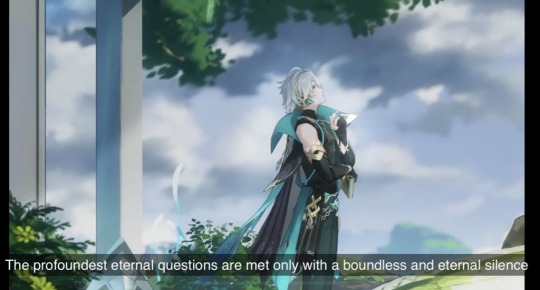
The profoundest eternal questions are met only with a boundless and eternal silence
This line in Alhaitham’s teaser is a reference to a poem by Bengali poet Rabindranath Tagore in the collection titled Stray Birds.
Tagore’s work is deeply religious in nature (heh) as it is largely influenced by the creation myths of the Rig Veda.
The recurring theme of nature, present throughout the entirety of Stray Birds, expresses and explores the relationship between man and spirituality in the tradition of Indian literature:
(...) when Tagore writes of nature —of birds, trees, a singular blade of grass, a sunset, sunrise, a boat ride, a fading view of water— while all of these external objects belonging to the natural world may make Tagore appear much like western Romantic poets, such as Wordsworth or Yeats, Tagore’s mission is actually quite different. In Tagore, what is expressed is a thoughtful relationship of poet to sacred text, of poet to the mythical or cosmological origins of the world.
In Tagore, love of nature equates at one level to love of God; for, in recognizing the worth of the natural world, one is giving assent to the fact that there is a God who created it.
(...) in Stray Birds Tagore writes:
“To-night there is a stir among the palm leaves, as well as in the sea
Full Moon, like the heart throb of the world
From what unknown sky hast thou carried in thy silence the aching secret of love?”
The lines echo the concept from the creation hymns wherein the sacred text posits that no one knows how creation came to be because no one witnessed it except for the creator God itself, and who can truly know this God but to seek him? As if this were not enough, also in Stray Birds, we read Tagore’s development of this concept as he writes:
”God comes to me in the dusk of my evening with the flowers from my past kept fresh in his basket”
This is the mind of a religious poet at work, not a Romantic poet.
—Love of Creation and Mysticism in Tagore’s Gitanjali and Stray Birds, by Paula Hayes
Silence is another major element of Tagore’s exploration of nature as the connection with god, which represents divine wisdom through introspection:
This power of silence is attributed to its heavenly origins. Silence is the voice of God, as well as the place where everyone finds and worships his god:
”God’s silence ripens man’s thoughts into speech”
In another poem, this eternal silence of Heaven is juxtaposed with the eternal quest of earthly creatures, a process that affirms the superiority of the former as the ultimate province of trust, beyond the doctrines and divisions created by the mind with their ensuing doubt and uncertainty:
”What language is thine, O sea?”
”The language of eternal question”
”What language is thy answer, O sky?”
”The language of eternal silence”
(...) Silence, therefore, is not merely a recurrent theme in the poems of Tagore, nor is it a distinct element that can be extracted from the rest of the poem. It is organically interwoven with other elements, establishing the unity of the poem, its coherence and its uniqueness as well.
—Language of eternal silence, by Muhhammad Hesham
In the poem referenced in Alhaitham’s teaser, the “eternal question” represents man’s quest to find meaning through spirituality, while the “eternal silence” represents introspection and a connection with the wisdom of God.
The role of eternal question fits a character like Alhaitham perfectly: one who seeks wisdom for personal fulfillment, but it is also one that questions this eternal silence —the word of god. One who raises questions against belief, not for the sake of negation, but understanding. An ethical atheist, if you will.
Alhaitham’s ideological worldview of individualism is inspired by the work of Max Stirner, originator of egoist anarchy. Stirner is highly critical of religion, but he also looks down on atheists of his time for replacing the god of western religion with morality and humanism. For him, true freedom can only be achieved through individualism.
Whether then the one God or the three in one. whether the Lutheran God or the être suprême or not God at all, but “Man,” may represent the highest essence, that makes no difference at all for him who denies the highest essence itself, for in his eyes those servants of a highest essence are one and all — pious people, the most raging atheist not less than the most faith-filled Christian.
—The Ego and Its Own, by Max Stirner
Stirner doesn’t seem concerned with denying the existence of god, but rather with the origin and care of his own desires, centering himself instead of “man” as a collective or an idea. He does not act for the good of anyone but himself (or that’s his ideal, at least).
Here’s where Haitham deviates from Stirner’s egoism. He’s not concerned with archons and he does favor individual comfort over Kaveh’s altruism, and he’s not afraid nor ashamed of trespassing conventional rules or institutional laws to get what he wants, but he does recognize the importance of order in society.
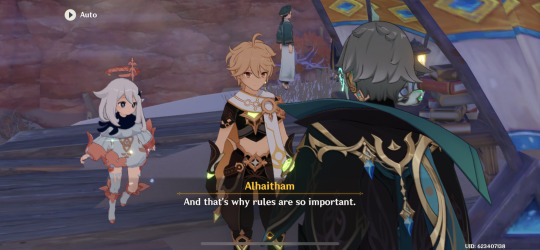
Sumeru is the nation ruled by the god of wisdom, so wisdom and knowledge can be understood as the fruit of worship for the archon. Akademiya rules are, much like in religion, a moral code that shapes the ideal believer and punishes those who break the order upheld under these rules.
Funny enough, the Akademiya’s original Chinese name is (according to the wiki) Sumeru Institute of Religious Decree —the religious context is lost on the English translation.
Understanding the Akademiya as an allegorical religious institution, Cyno serves as a guardian of the principles and moral code of this church. His historical predecessor is none other than priest Kasala, after all, who was a faithful follower of the Scarlet King (that he calls his “eternal lord”) and later aided Rukkhadevata.
Cyno’s priest-like figure is a fair counterpart to Alhaitham’s atheist: when the ethical atheist raises questions, it is the duty of the priest to answer on behalf of the divine.
The eternal question, an introspective search for answers and meaning; the eternal silence, the wisdom of divine scripture.
Alhaitham and Cyno are the only characters in Sumeru having an association with the theme of silence, especially Cyno. Alhaitham through Tagore’s poem and the description in his default outfit in which a member of the Temple of Silence warns the listener not to bother him if he’s wearing his headphones; and Cyno through direct references in his lore as well as his official affiliation to the Temple.
Much like in Tagore’s poem, the exchange of question and silence is not a hostile one, but rather a conversation, a means for growth for both sides. In dialectics, an argument is held for the same reasons: when offering a thesis, it must be reasonably defended against an equally reasonable contradiction.
Putting these two characters who fulfill these specific roles with religious undertones in a storyline where they work together to overthrow a government, then I simply am reminded of Enjolras and Grantaire from Les Miserables.

YOU SEE they’re part of the revolutionary group that fights in the barricades.

Enjolras is completely driven by ideology, every aspect of his life revolves around his ideals of revolution and freedom to the point that he just isn’t approachable by his colleagues. He’s more a walking ideal than human. While Grantaire is a skeptic who refuses to believe in anything (that is, except Enjolras) (they’re canonically super gay, the author went out of his way to compare them to a bunch of gay Greek historical and mythical couples so go figure).
Grantaire is rather a self indulgent nihilist, but Stirner’s vibes of cynical egoism are there (just described through the eyes of someone who does favor altruism instead lmao):
All those words: rights of the people, rights of man, the social contract, the French Revolution, the Republic, democracy, humanity, civilization, religion, progress, came very near to signifying nothing whatsoever to Grantaire. He smiled at them. Scepticisn, that caries of the intelligence, had not left him a whole single idea. He lived with irony. This was his axiom: “There is but one certainty, my full glass.” He sneered at all devotion in all parties, the father as well as the brother.
Grantaire believes in nothing, which is why he’s in love with the personification of ideal and belief.
A skeptic who adheres to a believer is as simple as the law of complementary colors. That which we lack attracts us. No one loves the light like the blind man. (...) Grantaire, in whom writhed doubt, loved to watch faith soar in Enjolras. He had need of Enjolras. That chaste, healthy, firm, upright, hard candid nature charmed him, without his being clearly aware of it, and without the idea of explaining it to himself having occurred to him. He admired his opposite by instinct.
Their contrast is mainly ideological, with Grantaire barely participating in the revolutionary acts of the group, but (although lesmis seems to be heavily shaped by religious narratives, especially Valjean’s main storyline) the way Enjolras is described very much fits Cyno’s own commitment to his duty as the General Mahamatra:
Enjolras was a charming young man, who was capable of being terrible. He was angelically handsome. He was a savage Antinous. One would have said, to see the pensive thoughtfulness of his glance, that he had already, in some previous state of existence, traversed the revolutionary apocalypse. He possessed the tradition of it as though he had been a witness. He was acquainted with all the minute details of the great affair. A pontifical and warlike nature, a singular thing in a youth. He was an officiating priest and a man of war; from the immediate point of view, a soldier of the democracy; above the contemporary movement, the priest of the ideal
Enjolras role as a revolutionary is heavily colored by religious and military undertones.
For most of the story Grantaire is rejected by Enjolras, often scorned by his lack of commitment and his lifestyle. It is at the last moment when Enjolras is cornered by a fire squad after the barricade fails that Grantaire declares himself a Republican and volunteers to die with him. Enjolras ideals have not succeeded in his quest for liberation, but Grantaire offers him a last hope in leaving his skepticism to believe in those ideals. If a skeptic was capable of believing, then surely it was not in vain and many others would carry Enjolras beliefs beyond his tragical death. And in taking his hand Enjolras basically accepts his feelings because les mis is of course a yaoi
Grantaire had risen. The immense gleam of the whole combat which he had missed, and in which he had had no part, appeared in the brilliant glance of the transfigured drunken man.
He repeated: "Long live the Republic!" crossed the room with a firm stride and placed himself in front of the guns beside Enjolras.
"Finish both of us at one blow," said he.
And turning gently to Enjolras, he said to him:
"Do you permit it?"
Enjolras pressed his hand with a smile.
This smile was not ended when the report resounded.
Enjolras, pierced by eight bullets, remained leaning against the wall, as though the balls had nailed him there. Only, his head was bowed.
Grantaire fell at his feet, as though struck by a thunderbolt.
Either way, haino in sumeru aq did succeed in overthrowing Azar and lived to tell the tale. But, well, they didn’t need this exchange. Alhaitham understands the value of rules, of Cyno’s duty, as they cooperate with each other.
so anyway yea enjoltaire haino, atheist and priest, gay ideological opposites of faith working together to overthrow the government u get it
further readings:
On the Couple of Silence by hibarifish
Alhaitham and Egoist Anarchism by lotusparadisaea
Love of Creation and Mysticism in Tagore’s Gitanjali and Stray Birds by Paula Hayes
Language of eternal silence by Muhhammad Hesham
#haino#cytham#long post#analysis#enjoltaire propaganda#listen i had to put the thoughts somewhere#Alhaitham#cyno#this is south park’s fault Elaborate on that No
69 notes
·
View notes
Text
I also really enjoy the way genshin explores these themes. People usually think that media/art either endorses or criticizes what it portrays - that whatever is being explored is a message, and the response from the audience has to be either to condemn or support
But sometimes they’re just thought experiments
Just sitting down and going alright let’s pretend the lies of capitalism are genuine, how do we make it work? And they build a system that ensures what capitalism promises, as idealistic as it comes, but they find out that the only way this system could ever work is if the participants have their collective freedom removed and their living conditions are deplorable, which is what we get and how capitalism operates in real life, but the writers instead take this reality into the convenient metaphor of meropide’s prison
They sit down and go alright let’s pretend Ayn Rand had something to say beyond jacking off to anti socialism, let’s use her rhetoric of personal freedom being limited by collective power in the context of mob mentality. And they make up a guy that resembles her idea of a power hungry mustache twirling villain who uses collective power as a tool for domination by taking away individuality, except they find out that personal freedom was limited not by the individual seeking power for himself, but by the environment of competence generated by capitalist values in the akademiya
1 note
·
View note
Text
sometimes genshin does interesting thought experiments (like meropide) and I always felt that there was something behind cyno’s role in sumeru in a similar way, but couldn’t figure out how
sumeru as a whole is SO interesting to analyze as a Marxist because of how politics were built around and projected through characters. I am not someone educated on these matters, so I can’t really dissect everything properly, but just looking from the outside is quite fun.
Alhaitham has a materialist approach in terms of worldview, while kaveh has an idealistic one. But kaveh is the character that embodies values we can loosely interpret as having something in common with communism, which uses materialist methodology. Alhaitham’s character ideology is based of Marx stirner’s egoist philosophy, and him and kaveh are based off a single character from ayn Rand’s novel The Fountainhead, which is basically a pretty mediocre ode to capitalism, except genshin took themes from it to develop them quite ingeniously while at the same time disagreeing with her rotten anti-socialist propaganda. Nilou’s story quest can be seen as an isolated exercise of Antonio gramsci’s theory of organic intellectuals, with her becoming more or less a one time union leader that defends the rights of the theater, a community that works on the basis of collectivism (the root and core of communism) or mutual aid (the root and core of anarchy) (the good one)
but cyno being such a key figure in the aq, I couldn’t figure out where he fell in all of this until I read dori’s voicelines and lore. Don’t remember if it was something specific or not though
(dori’s design is orientalist and hoyo should have done better)
she’s very openly a caricature of a capitalist but she’s playing two roles at the same time: that of the free market under capitalism, and that of the illegal market that rises as a consequence of the regulations imposed by the capitalist state
genshin is playing around with the role of the state in the nations, I have to go back to the other nations to check if the did anything like this before, but sumeru and meropide stand out in this aspect
meropide is the idealistic form of state capitalism (or at least what capitalism lies to be), where the system works fairly and with equal opportunity because the state regulates the market - the state in this context is Wriothesley himself, who holds all executive and legislative power (I’m not sure about judicial? was there punishment in the prison?)
meanwhile in sumeru this doesn’t work quite well. There is already an allegory of wealth accumulation through the accumulation of knowledge and academic merit in the akademiya, but the relationship with the market is quite textual: The matra, judicial power, persecutes and tríes to contain the market (dori) whether official or illegal
if the matra represent one state power, then where are the other two? The grand Sage is the one with executive power, but he also seems to have legislative since it is azar who decides what directives to add or remove into the akasha on jnagarbha day.
and then i don’t even know where to start in Fontaine. I think it might also be a nod to Ayn Rand’s stupid novel and the climatic scene where the protagonist defends his 🇺🇸🦅🗽freedom🗽🦅🇺🇸 in a courtroom
it’d be funny if they intended the powers to be separated into furina (executive), Neuvillette (legislative), focalors/that thing (judicial) but also it’s still all mixed up(?)
0 notes
